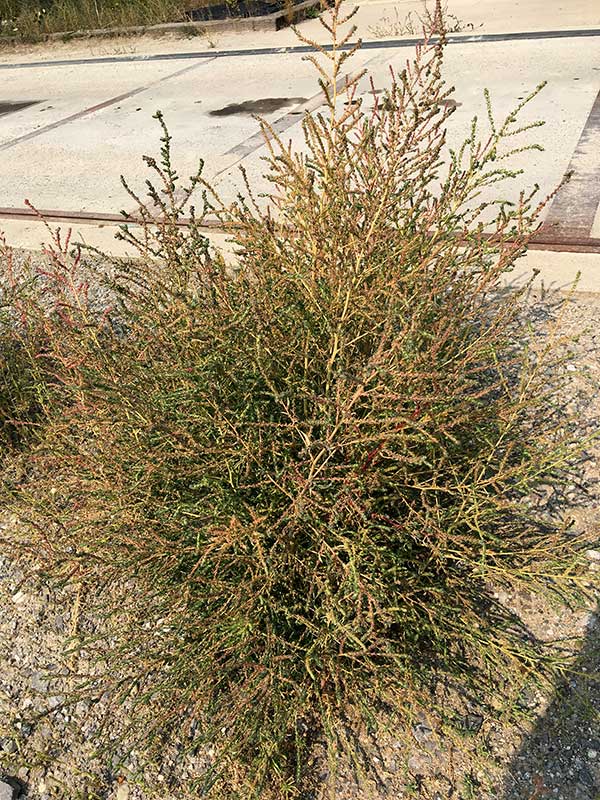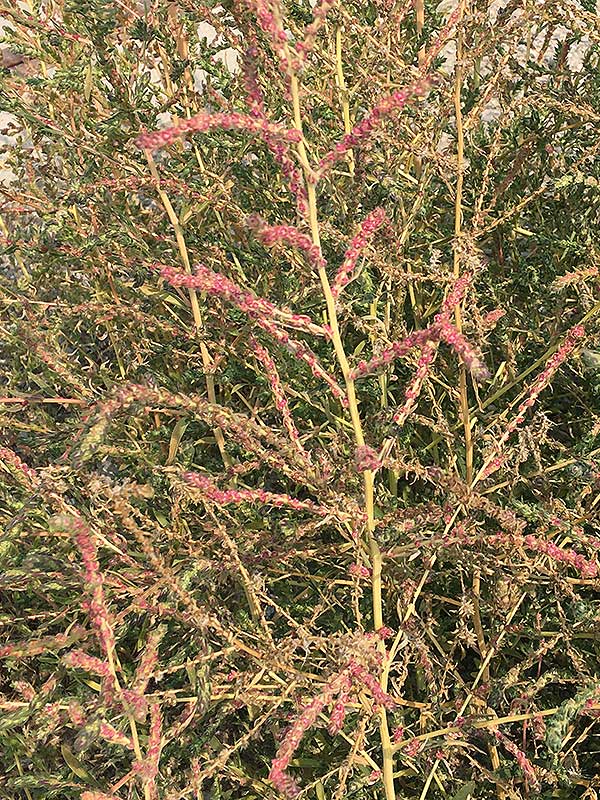Bassia scoparia / burningbush
- large, annual herb (forb)
- leaves long-ish and narrow
- inflorescence a highly branched spike with teeny green/yellow flowers
- may form huge, invasive colonies
- whole plant turns red in fall
- a tumbleweed
- especially in disturbed areas and wastelands in the Valley
Also known as: summer cypress, ragweed, mock-cypress, kochia, Mexican firebush, Mexican fireweed, common red sage
Synonyms: Kochia alata, K. scoparia, K.sieversiana, Bassia sieversiana, Chenopodium scoparium
Note: this “burningbush” is totally unrelated to the ornamental (but invasive) shrub by the same name, Euonymus alatus.
Bassia scoparia (known, up until 2016 as Kochia scoparia) is a large annual forb (herb) native to Eurasia. In North America, it was introduced and is now found in grasslands, prairies, and desert shrub ecosystems. In the Valley, it is fairly common in disturbed areas, parking lots, construction sites, wastelands and the like. As testimony to its high stress tolerance, in other areas it has been grown in oil well pits and on strip-mined lands. On the other hand, it has been reported in nearby states in floodplains, marshes and temporary mudflats. Besides being both flooding and drought tolerant, it is salt and alkali tolerant.
All this tolerance also enables it to be highly invasive, and in some states it is considered a noxious weed due to its ability to displace other vegetation. By exuding chemicals from its roots, it can inhibit the growth of other plants, a feature known as allelopathy. Burningbush also competes with crops and interferes with their harvest. This is probably especially important in the Valley where the relatively new crop, quinoa, is planted since the species are related and can even look similar. It is pretty much the case that no state ag service would ever recommend planting this species, except (with lots of caveats) for restoration of degraded lands, simply because its escape is pretty much assured. Nevertheless, you can buy the seeds on Amazon. Go figure.
Looking at the plants themselves, the stems are erect and often much-branched. As a result, their overall appearance is often pyramidal or “globular”. The stems are green when young, but turn orange, then red with age; hence the common name, burningbush. As I put this entry together at the end of summer, 2020, this was pretty much the only form still apparent. Hopefully, when growth resumes in 2021, I will update the gallery. Or even more hopefully, I won’t be able to find any.
Burningbush leaves are long (up to 4″) and narrow, a feature that clearly distinguishes them from things like goosefoot or pigweed or quinoa to which they are closely related. The leaves have a fringe of hairs on the margins; they are very short petioled or sessile. Like Atriplex (pigweed) the leaves have 1-5 quite prominent veins. This is an anatomical and morphological adaptation of a specialized and very efficient type of photosynthesis, called C4.
The flowers of this species are very small, and yellow or green. They lack petals and are best called “inconspicuous.” The flowers grow in the axils of green leaf-like bracts. The individual flowers are surrounded by hair. There is nothing particularly attractive about them, like all the other members of their family. The inflorescence is a spike and is axillary and terminal, meaning that every small branch can end in an inflorescence. Indeed, the branches aren’t necessary; the inflorescences can just grow straight out of the stem axils.
Bassia scoparia reproduces exclusively by seed of which the plants produce prodigious amounts. However, the seeds do not persist in the seedbank for even one year. Once the fruits (containing single seeds) are dry, the stems typically break off and burningbush is one of several “tumbleweeds” in the west. This turns out to be a great way to distribute seeds.
Plants germinate early in the spring, enabling them to utilize the limited spring soil moisture in arid/semi-arid regions. They can also germinate anytime during the season, even under high stress conditions (drought, salinity, alkalinity etc.)
One of the features that helps make burningbush so stress and disturbance tolerant is the root system. Taproots generally penetrate to 6 to 8 feet, but may get as deep as 16 feet under severe droughts. The fine and lateral roots extend out as far as 20 feet from the main stem.
Despite the fact that burningbush is a horribly invasive and potentially toxic if consumed at high levels, it is considered good forage for both domestic and native grazers. The fruits/seeds are important forage for upland game birds.
Interesting bits – Bassia scoparia was introduced to North America in the early 1900s but spread especially during the dustbowl years of the 1930s. In between, it was already notorious but took on some kind of romantic thing when Bob Nolan wrote the song, “Tumbling tumbleweeds”. Among others, Gene Autry and Roy Rogers (and the Sons of the Pioneers) recorded it.
Burningbush also does so well in part because of its high genetic diversity. While this varies considerably from place to place, it tends to be much higher within populations than between them. This reflects extensive gene flow by cross pollination (by insects) and seed dispersal over long distance by “tumbling”. The diversity has resulted in significant resistance to a whole slew of strong and nasty herbicides.
Burningbush has a weird diversity of uses. For example, in Japanese cuisine, it is used as a food garnish – the seeds have a texture similar to caviar (they say). Thus, it has been called “land caviar”, “field caviar”, and “mountain caviar”. Alternately, one can tie several plants together to make a sort of broom… use the stems as handles. And at the completely opposite end of the scale, it has been used as a plant for reclamation of badly degraded sites because it is a hyperaccumulator of chromium, lead, mercury, selenium, silver, zinc, and uranium as well as various hydrocarbons. I would suggest not using seeds from those sites to make your caviar.
And finally, burningbush seeds produce a pheromone that attracts mosquitos, and has been used to bait them to insecticides.
| Color | |
|---|---|
| Family | |
| Blossom size | |
| Inflorescence size | |
| Inflorescence type | |
| When? | |
| Where? | disturbed, exposed, roadsides, widespread, with sagebrush, xeric (dry) |



